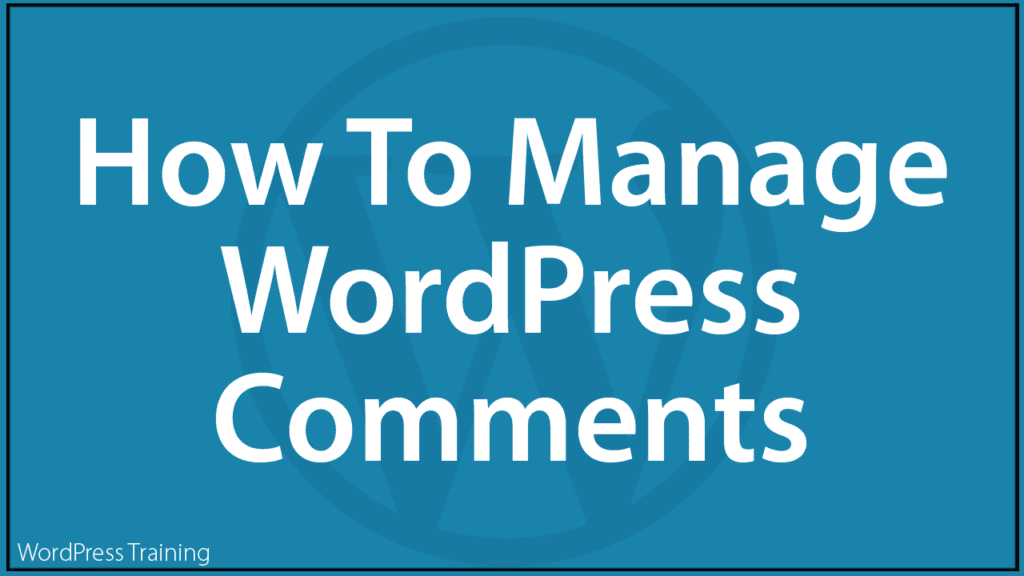How To Manage Comments In WordPress
 In this tutorial, you will learn how to manage user comments in WordPress.
In this tutorial, you will learn how to manage user comments in WordPress.
This tutorial covers the following areas:
- What you need to do first
- Enabling/disabling and configuring comments sitewide in the WordPress Discussion Settings section
- Enabling/disabling comments in Posts and Pages
- WordPress comment management:
- WordPress comments screen functions:
- Keyboard shortcuts for comments
- Displaying user comments on your site – widgets, blocks, and RSS feeds
- Comment plugins
- Dealing with comment spam
***
Allowing users and visitors to leave comments on your posts is an effective way to increase user engagement and interaction on your site.
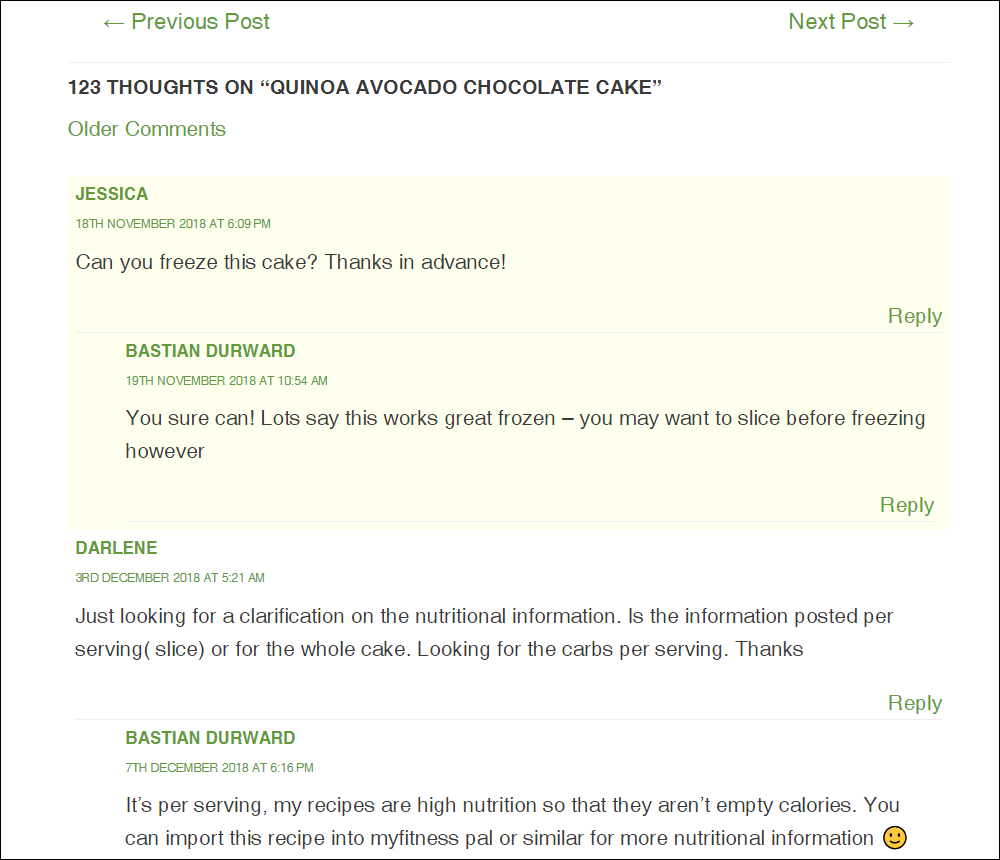
WordPress Comment Management – What You Need To Do First
Before we go any further into how to manage comments on your WordPress site, there are a couple of things you need to do first:
- Decide whether you want to allow comments on your site, and
- Configure your WordPress Discussion Settings.
Do You Want Visitors To Leave Comments On Your Site?
Depending on the nature of your business and how you want to run your site, you may not want or need users to leave comments.
Allowing Comments – Pros
Allowing people to post comments on your site has many positives:
- It can help build a community of engaged users.
- It creates a two-way communication channel with your audience.
- It provides opportunities to get valuable feedback, answer visitors’ questions, address concerns and objections, etc.
- It can generate healthy discussions and lead to ideas for new content, products, services, etc.
- It helps build a relationship of trust and credibility with your readers.
- It provides a form of social proof for your business.
- It can lead to new subscribers and new customers.
Allowing Comments – Cons
Comments, however, require management and moderation.
Consider these points before deciding whether or not to allow comments on your site:
- Replying to comments requires an investment of time and effort. Your replies need to be unambiguous and thoughtful. If responses are not clear and considered, users will be left confused, disappointed, frustrated, or even angry and they will let you (and everyone else) know this in the comments.
- A lack of ongoing management of comments can turn your site into a target for comment spammers.
- Posts with comments left unmoderated can quickly descend into personal discussions on unwanted or negative topics.
- Not replying to comments left by visitors in a timely manner can lead to a negative user experience, poor reputation, and loss of sales.
Commenting, then, is a powerful feature of WordPress, but it’s ultimately your business and your decision whether to allow commenting to take place on your site or not.
You may want to do things differently. For example, you can choose to:
- Disable comments on your site but offer a support helpdesk and other ways for users to contact you if they have questions, comments, feedback, or issues.
- Disable comments on your site and build an engaging community on social media where meaningful conversations and discussions can take place.
- Allow comments only on certain posts and only for a certain period of time (e.g. 7 days after posting, then the post becomes closed for new comments).
Configuring Your Discussion Settings
Once you have a clearer idea of how you plan to use comments on your site, the next step is to make sure that your site’s commenting settings are configured correctly.
This is done in your site’s Discussion Settings section (Settings > Discussion).
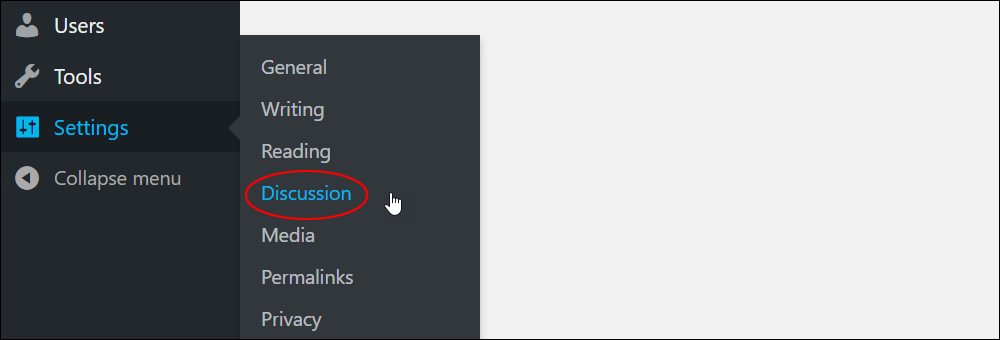
![]()
Notes:
- Normally, only users assigned the role of Administrator have permissions to configure Discussion settings.
- Users assigned the role of Editor and higher can also manage and edit comments left by users on the site.
To learn more about different user roles, see this tutorial: How To Manage WordPress Users
Enabling And Disabling Comments
In WordPress, you can configure settings for comments sitewide and then choose whether to enable or disable comments on a per post or page basis.
Comments – Sitewide Settings
The WordPress Discussion Settings section lets you control how visitors and other users engage with your site, including via the use of commenting.
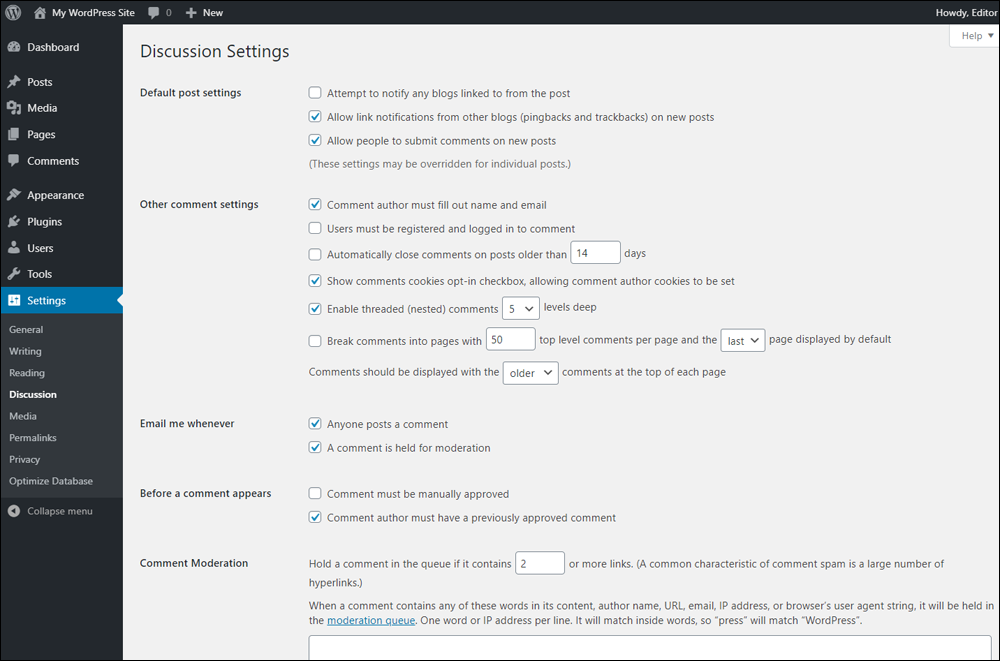
Your site’s Discussion Settings section lets you specify whether or not to allow people to submit comments on new posts.
If you choose to allow commenting on your site, then you can specify additional settings like:
- Whether users must provide their name and email address before they can post a comment.
- Whether users must be registered and logged in before they can comment.
- The number of days before comments are closed to new users.
- Whether to next comments and if so, how many levels deep.
- Whether to break comments into pages and if so, how many comments per page and whether to display the most recent comments’ page first or last.
- Whether to display comments with the oldest or newest comments at the top of each page.
- Email settings when someone posts a new comment or if a comment is held for moderation.
- Conditions for approving comments.
- Comment moderation settings.
- Disallowed words in comments.
- Comment user avatars.
- Etc.
If you need help configuring your site’s discussion settings, see this tutorial: How To Configure WordPress Discussion Settings
Comments – Per Post Basis
You can override global settings for comments on individual posts and pages.
If you want to enable or disable comments without opening your post or page editing screens, you can do this for individual or multiple posts or pages from the WordPress Quick Editor…
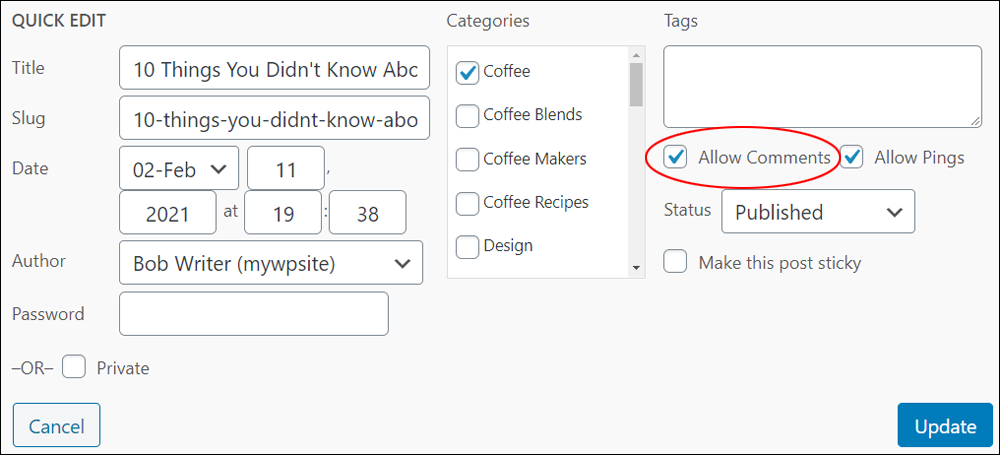
You can also enable or disable comments when creating or editing individual posts or pages using the WordPress Classic Editor…
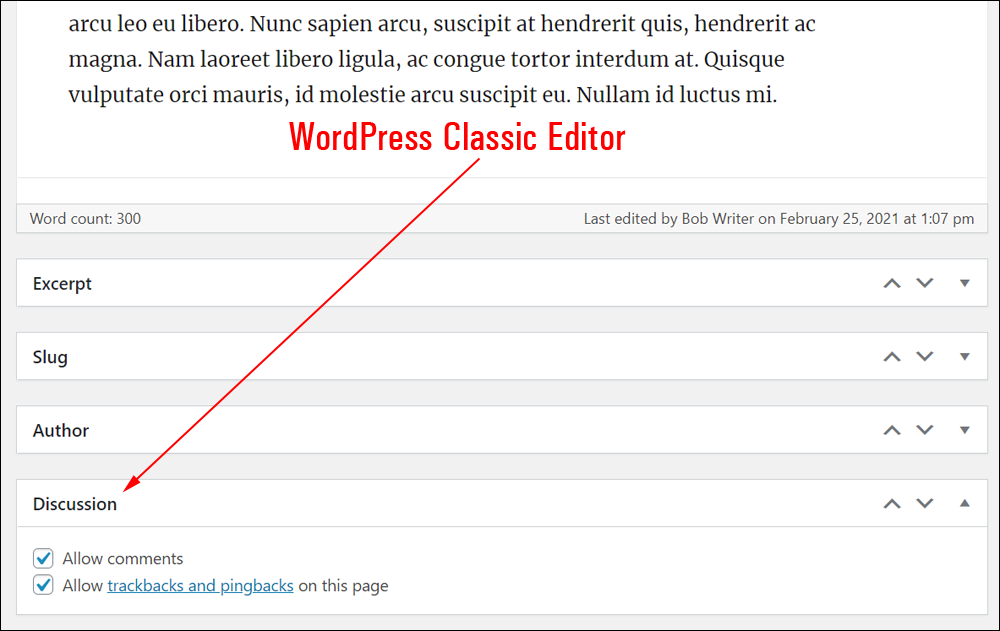
Or the WordPress Block Editor…

If you need help with any of the above, see these tutorials:
- How To Edit Posts In WordPress
- How To Edit Pages In WordPress
- WordPress Block Editor – Settings Section
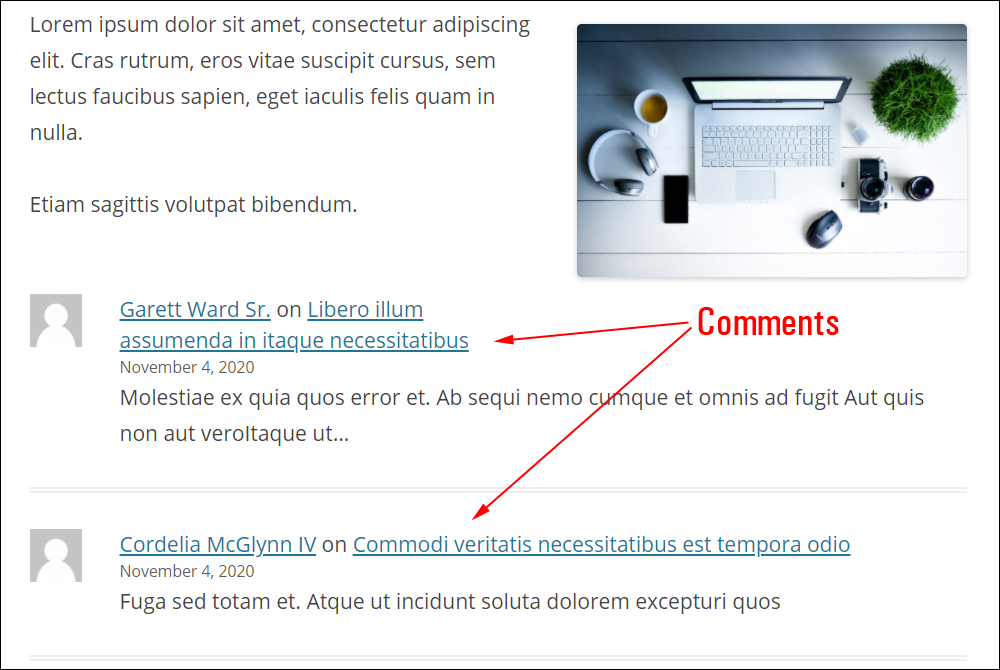
Now that we have looked briefly at configuring comments settings, let’s go through how to manage comments left on your site by users.
WordPress Comment Management
WordPress provides several effective ways to view and manage comments left by users on your site.
Comment Links On Posts And Pages
If you’re logged in when you visit your website, you will see ‘reply to’ and ‘edit’ links displayed for all comments on your site’s posts and pages (we cover these further below).
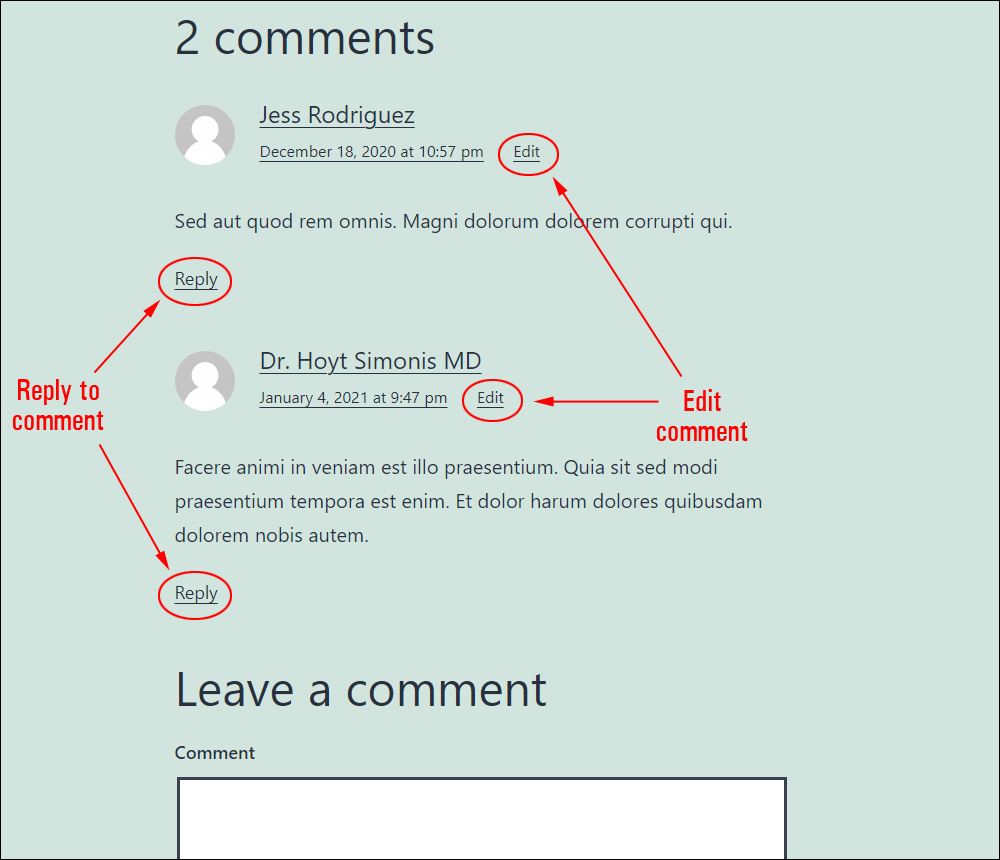
Dashboard Comment Notifications
From your dashboard, you can manage comments as follows:
- From the admin toolbar – view the number of comments in moderation and click the comments icon to go to the Comments section.
- From the main menu – view the number of comments in moderation and click the Comments menu item to go to the Comments section.
- From the ‘At a Glance’ pane – view the total number of comments on your site and the number of comments in moderation and click on either of these to view all comments or only comments awaiting moderation in the Comments section.
- From the Activity panel – View all Recent comments, visit the commenter’s site, view the post the comment was left on, and perform comment editing tasks.
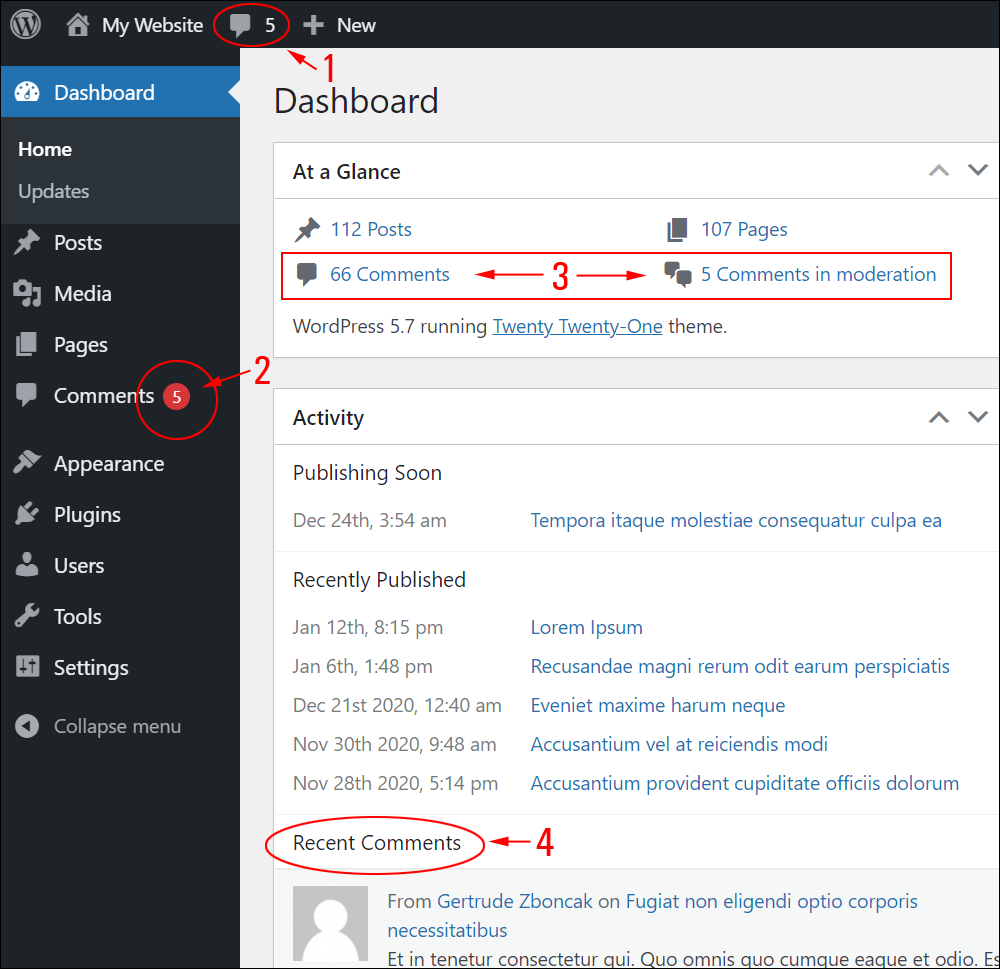
Comments Section
To view manage all comments left on your site by users, visitors, members, etc. click on Comments in your main menu.
This will bring up the ‘Comments’ screen.
If there are no comments yet, the Comments screen will be empty.
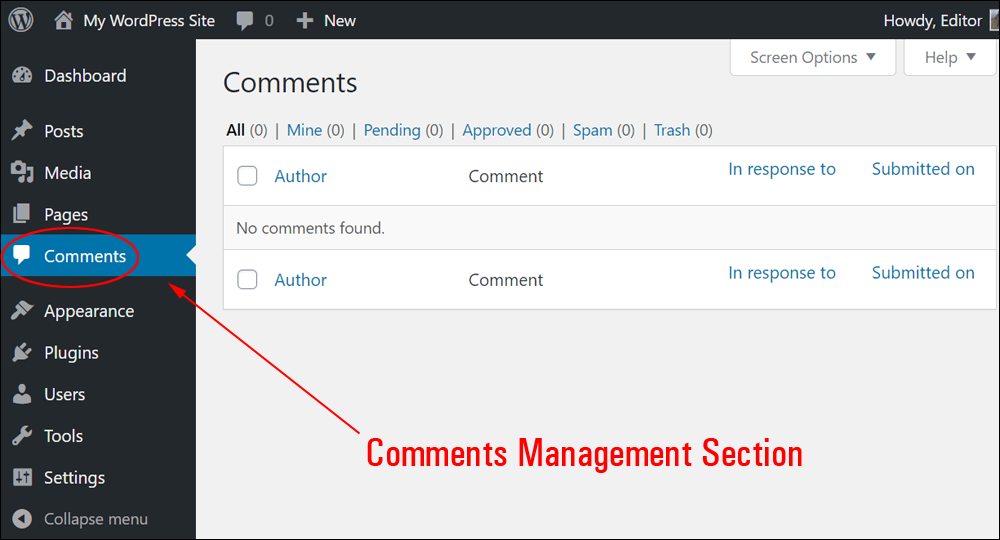
You can manage comments in the same way that you manage posts and other content on your site.
You can customize screen options just like other management screens and act on comments using the on-hover action links or the bulk actions. This is covered further below.
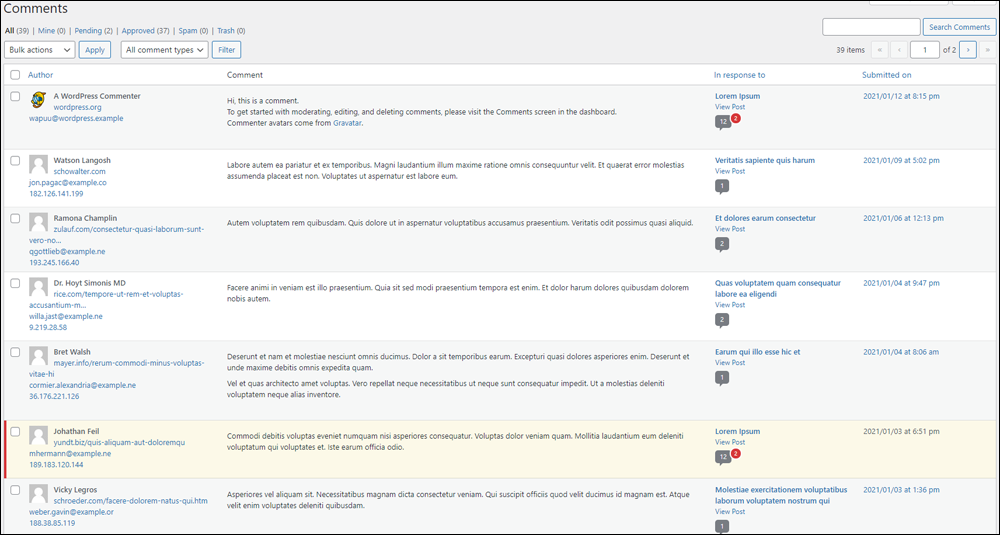
In the Comments section, hover over to a comment to display a menu with action links.

Notes:
You can also manage comments from the Recent Comments panel in your dashboard.
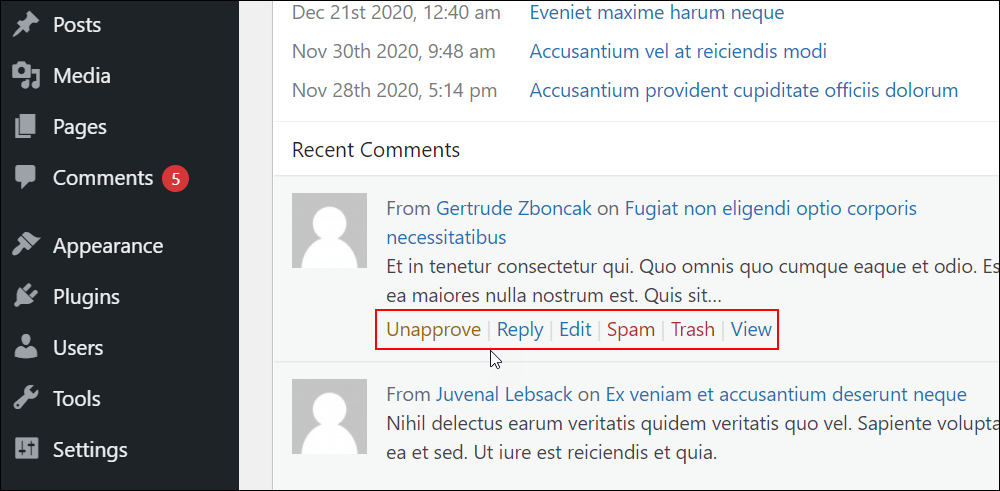
And you can also go to the Comments section by clicking on the notification icons in the Comments column of your Table of Posts or Table of Pages.
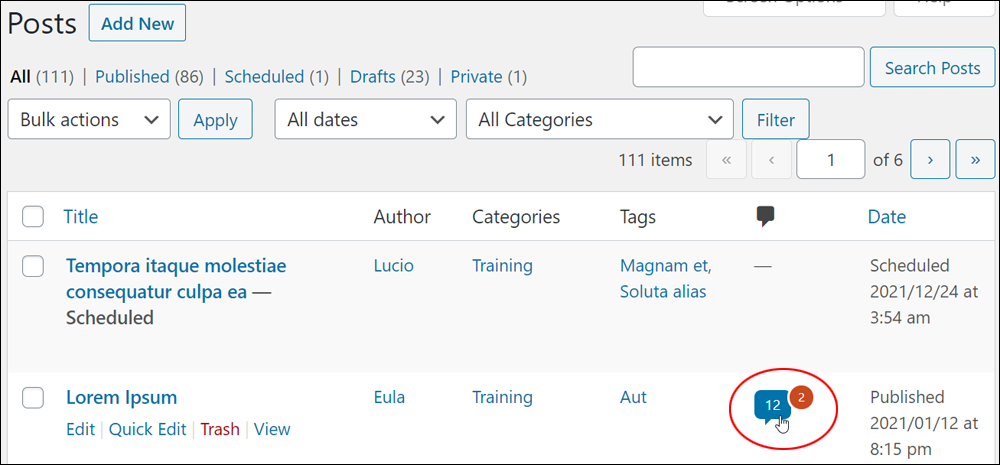
Notes:
- Gray notification icons turn blue when you hover and show the number of approved comments for that post or page.
- Red icons show the number of comments still being held in moderation.
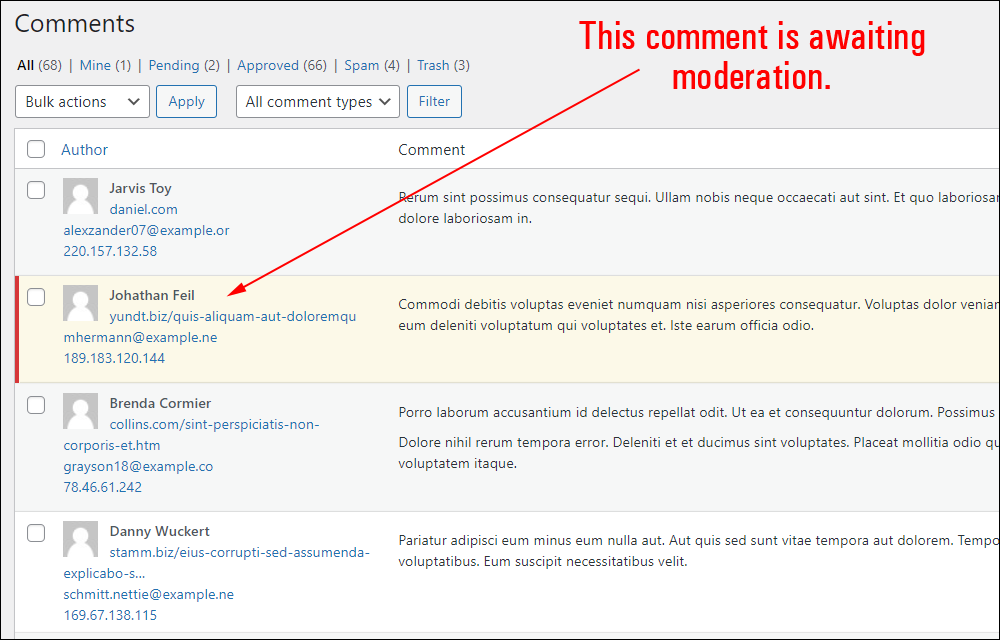
If you have enabled commenting on your site or individual posts or pages, comments will be assigned different statuses depending on how you have configured your Discussion settings.
Comment statuses include:
- Pending: comments submitted by visitors aren’t made visible on your site unless or until approved.
- Approved: comments are published and made publicly visible on your site.
- Spam: comments flagged as possibly unwanted or irrelevant and not visible to site visitors.
- Trash: comments marked as unwanted and sent to the trash are automatically and permanently deleted after 30 days.
![]()
What’s the difference between marking comments as Spam or Trash?
When you send a comment to Spam, you are ‘teaching’ your anti-spam plugin or service that the message is spam. This plugin or service will then learn how to recognize similar comments in the future and automatically flag them as spam.
When you send a comment to the Trash that message simply disappears, and nothing further happens to it.
Let’s go through how to manage comments in the Comments section.
Approve/Unapprove Comments
Once a visitor submits their comment, WordPress follows the preferences specified in your settings and either holds the comment for approval or posts it immediately.
Approving a comment makes it visible to your site visitors. Unapproving it puts it into ‘Pending’ status.

Reply
Click on the Reply link to reply to comments.

This will open an inline editor where you can enter your reply. Note: you can format your reply text, add links, images, bullets, code, etc.
Click the Reply button when done.
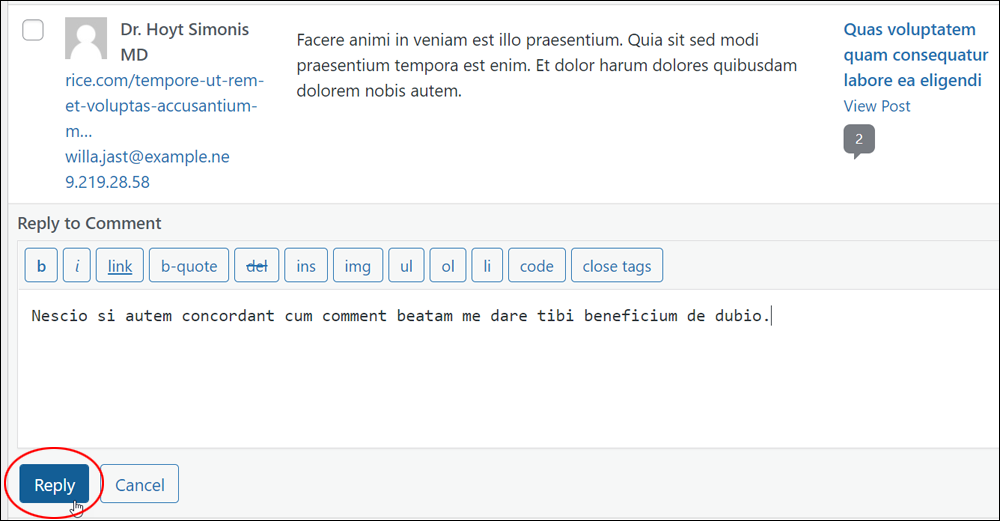
Your reply will display below the comment in the Comments section.
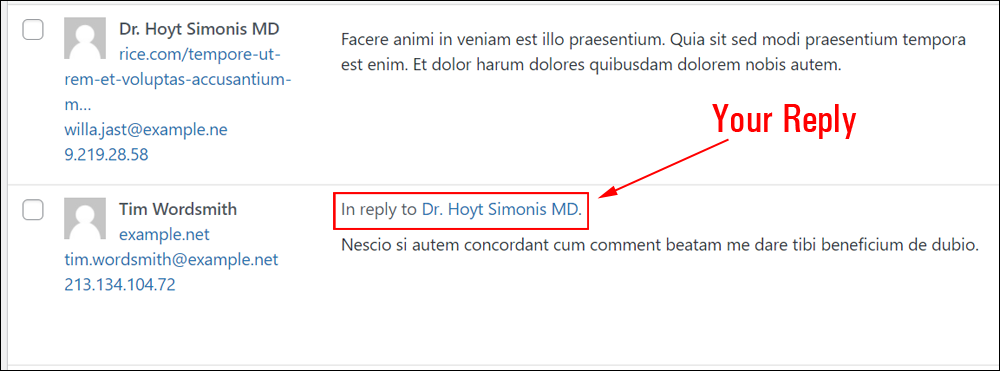
Note that when replying to specific comments, your reply will normally display under the comment, creating a “threaded” or “nested” comment.
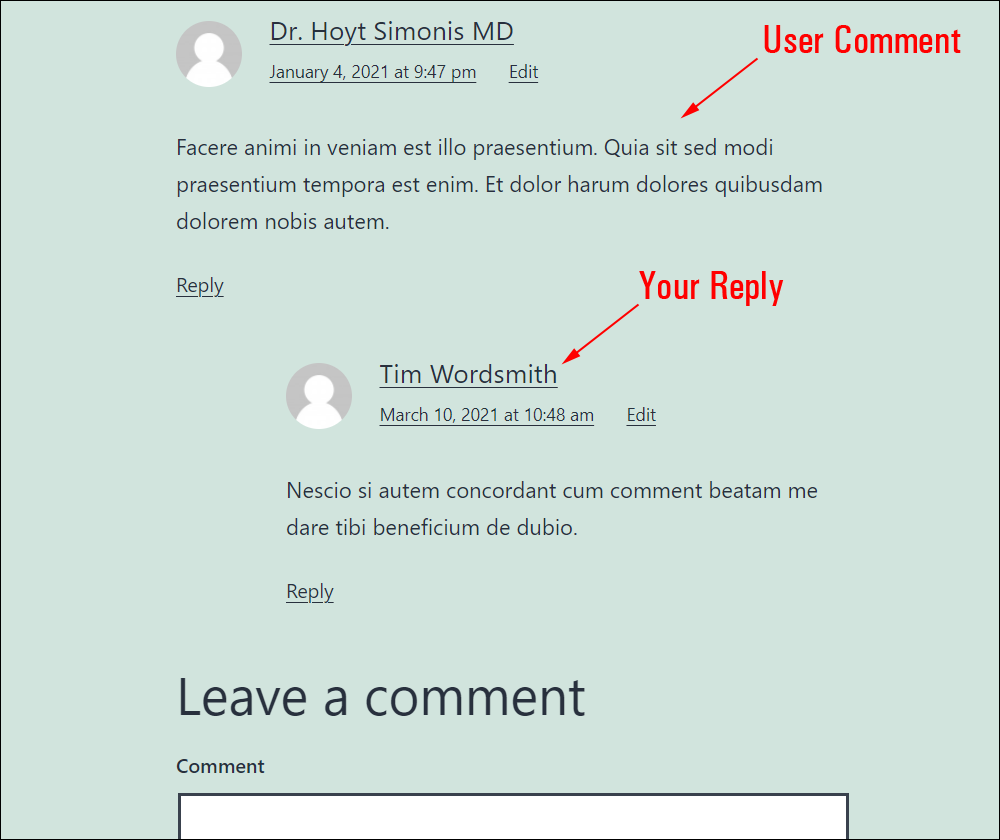
WordPress, in fact, allows multiple levels of nested replies (up to 10). You can specify the number of threaded levels of comment replies in your Discussion settings.
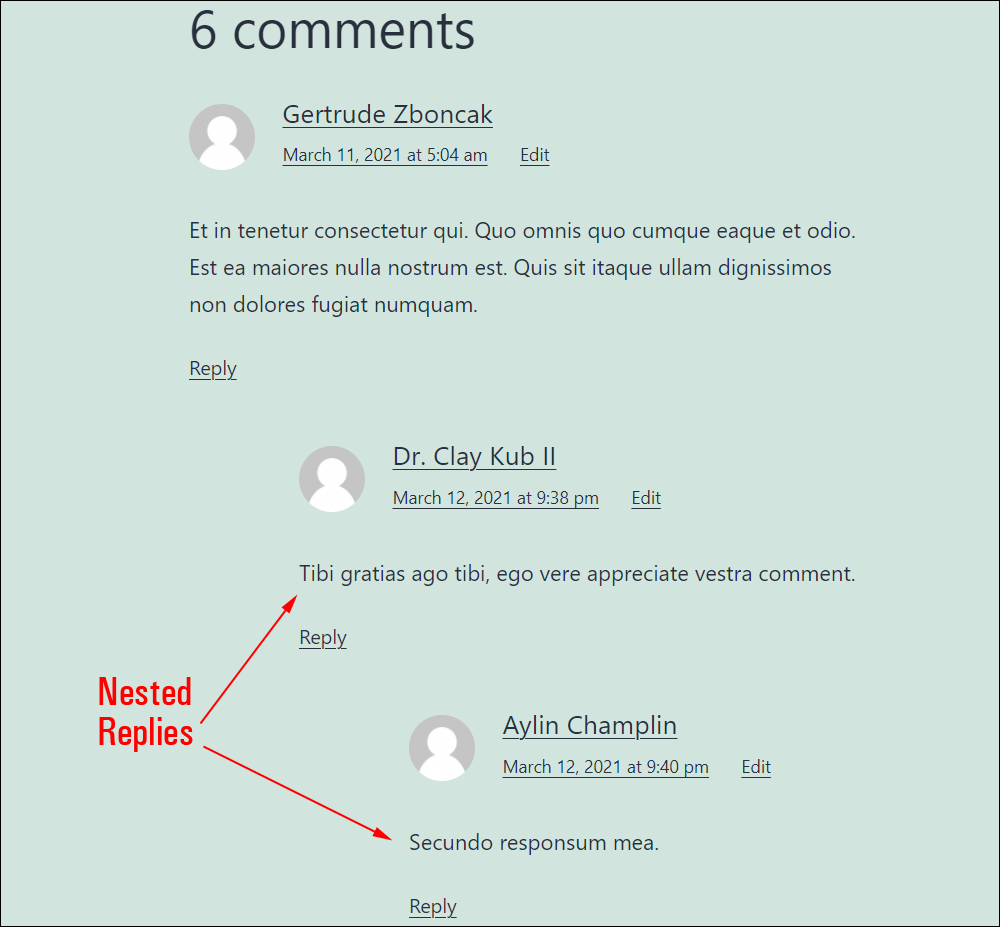
To reply to comments while viewing a post or page without leaving the post or page, click on the Reply link below the comment, then type in your reply and click the Post Comment button, or click ‘Cancel reply’ to exit without replying.
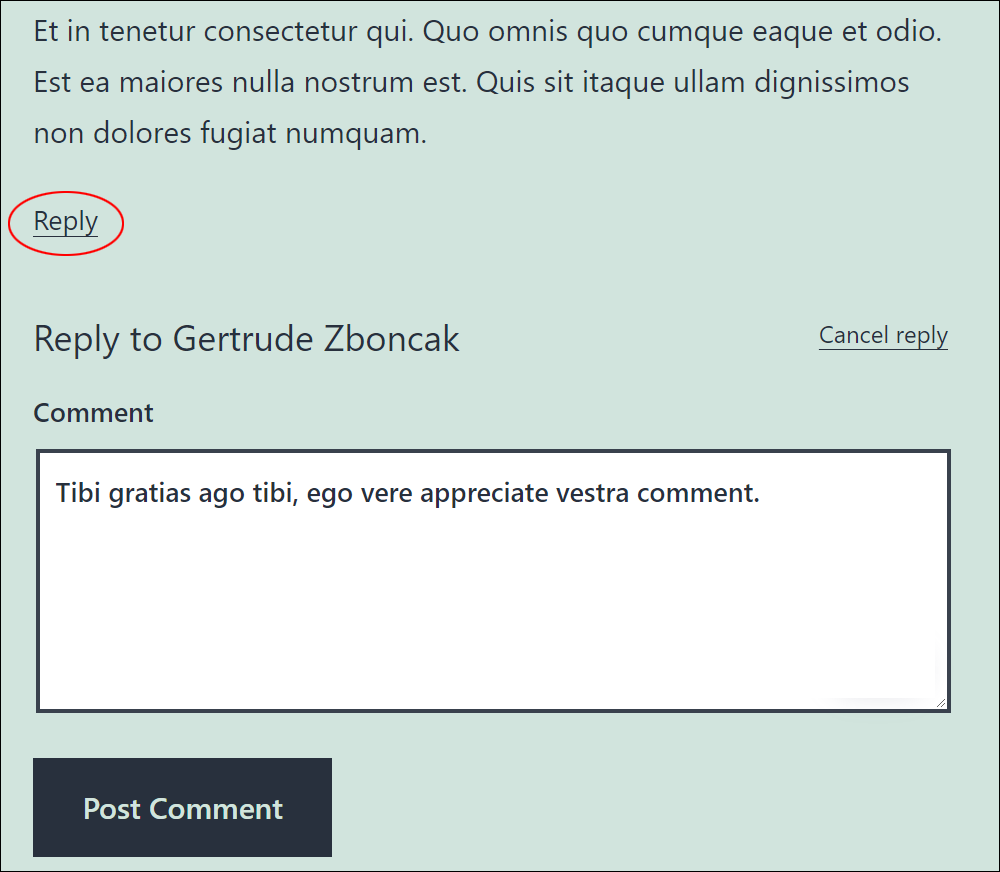
Quick Edit
The Quick Edit option opens a text area where you can edit the comment without reloading the page.

This opens the Edit Comment screen for the Quick Editor, allowing you to edit and format the comment, and change the commenter’s name, email address and website URL.

Edit the comment and click the Update Comment button when done or click Cancel to exit the editor without saving your changes.
Edit
Click on the Edit link to edit a comment.

The Edit function gives you a few more options than Quick Edit when editing a comment.
In addition to performing the same editing functions as the Quick Editor, you can change its status (approved, pending, or spam), change its submission date, view the post it was submitted on, or move it to the trash.
After editing your comment, click the Update button to save it, or click on the Comments item on the main menu to return to the Comments screen without saving your changes.
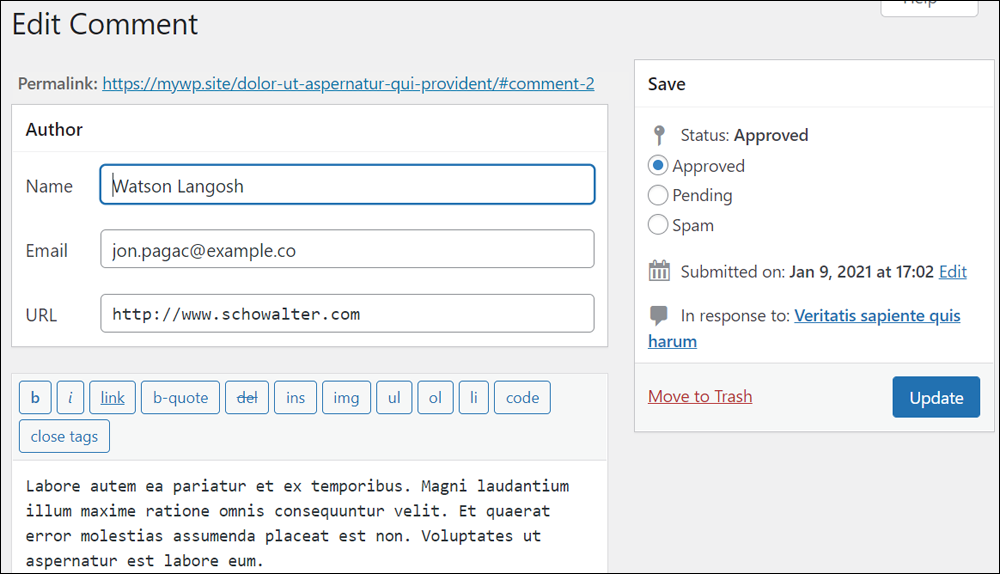
When visiting your website, you can also edit a comment left on a post or page by clicking on the Edit link next to the comment.
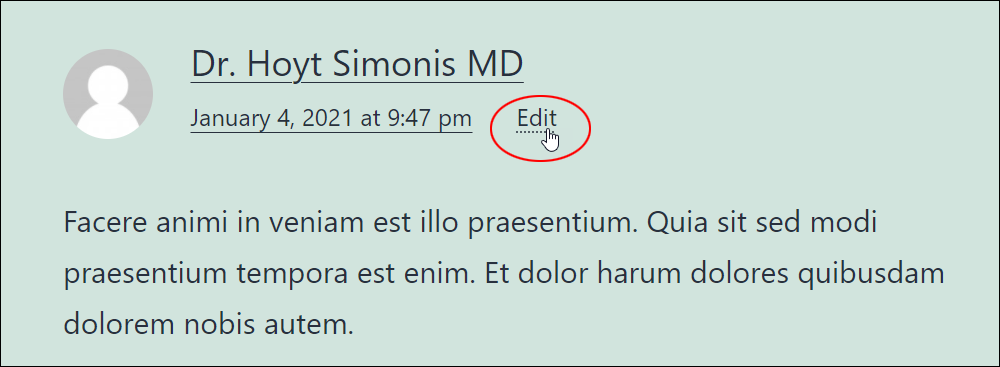
This will bring you to the Edit Comment screen where you can make any required changes.
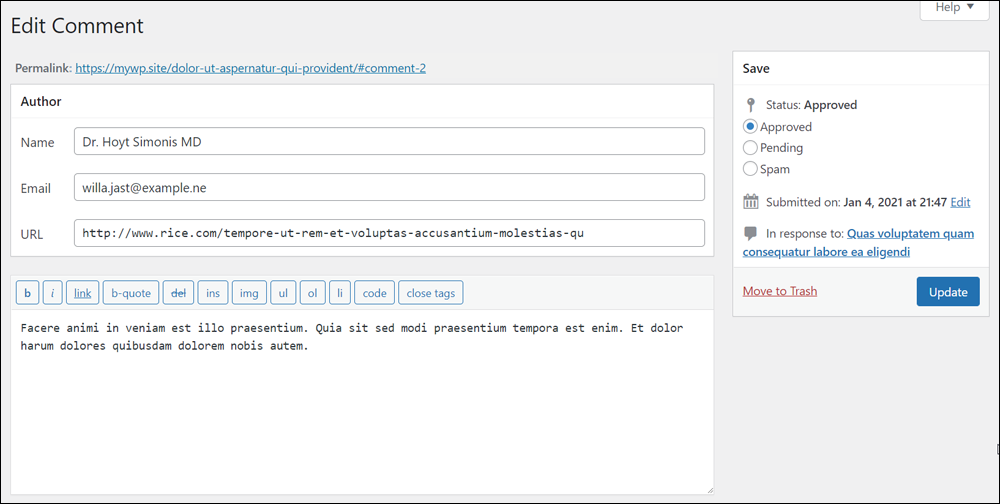
Spam
To mark a comment as spam, locate the comment and click on the Spam link.

To undo this action immediately after marking a comment as Spam, click on the Undo link in the notification message.

To undo marking a comment as Spam immediately after taking action, click on the Undo link in the notification message.

To view all comments you have marked as Spam, click on the Spam status menu link at the top of the Comments screen.

If you want to take any further action in the Spam section, hover over the comment to bring up a menu of additional options, then click on either of these links:
- Not Spam – If you see a real comment has been marked as spam, you can mark it as Not Spam by hovering your mouse over it. This will return the comment to the Comments section.
- Delete Permanently – Click this link to permanently delete the comment.
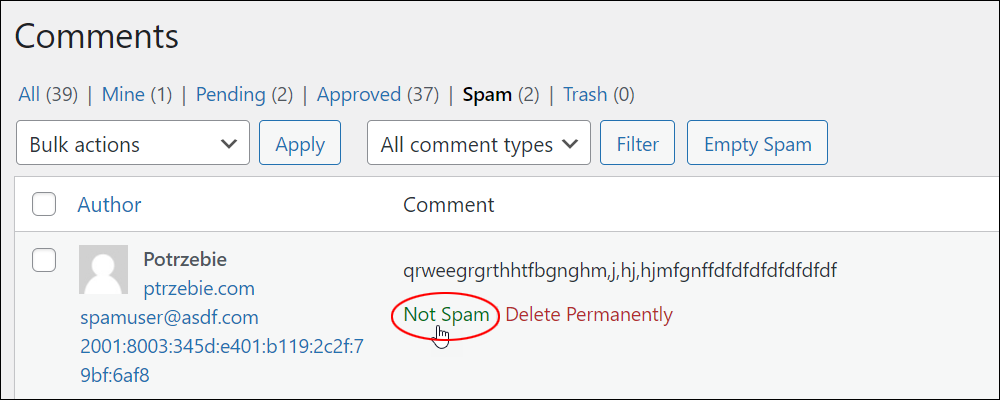
You can also empty the Spam section by clicking on the Empty Spam button.

Note: See the end of this tutorial for useful tips and information on dealing with comment spam.
Trash
Deleted comments are sent to the trash section. Trashed comments remain there for 30 days. After this time, WordPress deletes the comments permanently.
To send a comment to the trash, hover over the comment and click the Trash link.

A notification message will inform you that the selected comment has been moved to the Trash.

If you accidentally trash a comment, you can restore it by clicking on the Undo button.

To view all trashed comments, click on the Trash status link in the Comment Status menu.

To perform additional functions on comments in the trash section, hover over the comment and select one of the available options:
- Spam – Click this link to move the comment from the Trash to the Spam section.
- Restore – Click this link to Restore the comment and move it out of the Trash.
- Delete Permanently – Click this link to permanently delete the comment.
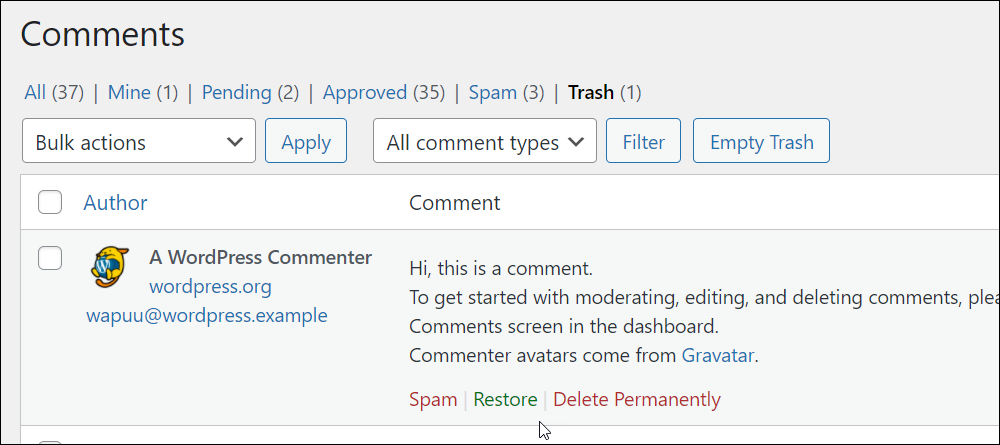
To delete all comments in the Trash section, click on the Empty Trash button.

All comments in the Trash section will be permanently deleted.

Comments Screen
Earlier, we stated that you can manage comments in the same way that you manage posts and other content on your site.
You can also customize screen options just like other management screens.
Let’s go through these now.
Screen Options
To view options for customizing your Comments screen, click on the Screen Options tab at the top of your screen.
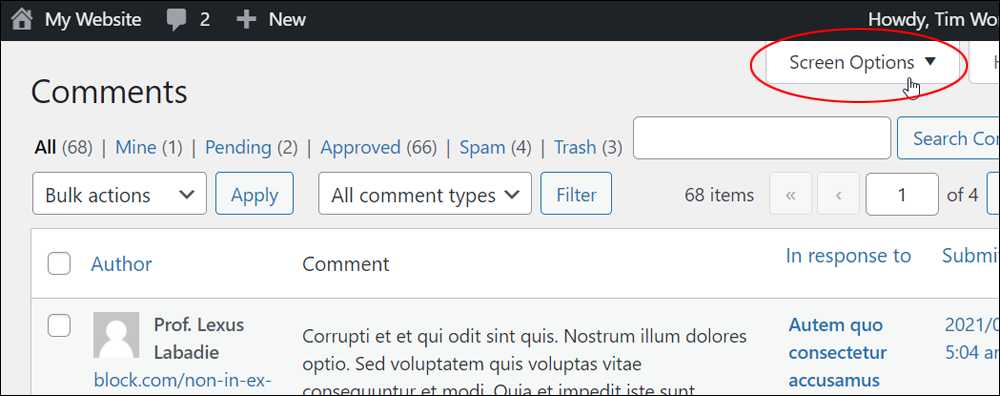
The Screen Options Panel will expand and display the following options (alternatively, untick a checkbox to disable options and prevent these from displaying in the Comments screen):
- Columns – You can enable the following options in the Columns section by ticking the checkboxes:
- Author – Displays the Author column, with the author’s name, email address, site URL, and the commenter’s IP address.
- In response to – Displays a column with the name of the post where the comment was made and links to the post editor for that comment.
- Submitted on – Displays a column with the date and time the comment was left on your site.
- Pagination – Specify the number of comments to display on each page of the Comments screen.
- View mode – Select between Compact and Extended views. In Compact view, the functions menu remains hidden until you hover over the comment. In Extended view, the functions menu is permanently visible on every comment.
- Note: Installing certain plugins or themes may add additional options to this section.
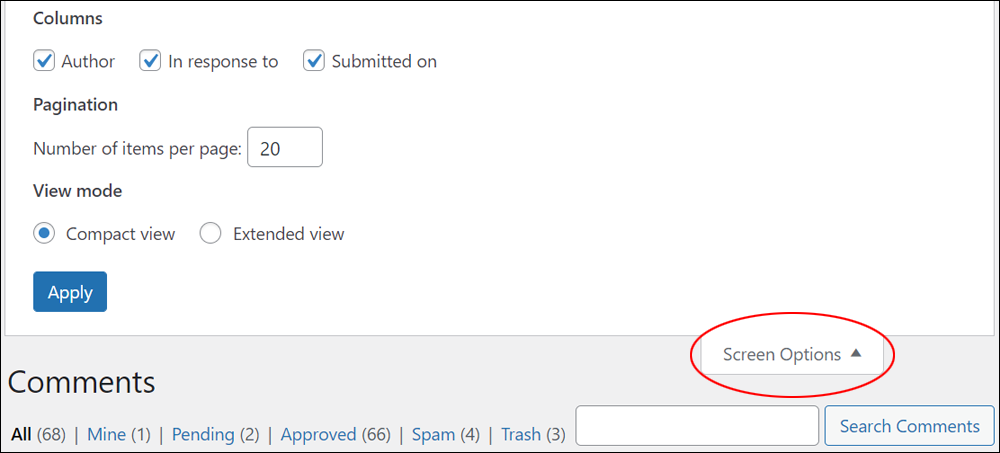
Remember to click the Apply button when done to save your new screen option settings.
Comment Screen Functions
The Comments screen has several useful functions to help you find and manage your comments more effectively.
Sort Comments
If you cannot view all the columns described below on your Comments screen, make sure you have the columns enabled in your Screen Options tab (see the section above).
Click on the little black triangle next to the Author column to sort comments alphabetically (or click again to sort comments in reverse alphabetical order) by author.

You can also sort comments by post title in the In response to column.

And you can do the same for the Submitted on column.

Bulk Edit Comments
You can perform bulk actions by selecting multiple comments and choosing an option from the Bulk actions dropdown menu.
Note that different options will display in the Bulk actions menu depending on the Status filter you select.
For example, if you are viewing All comments, the Bulk actions menu will display all options.
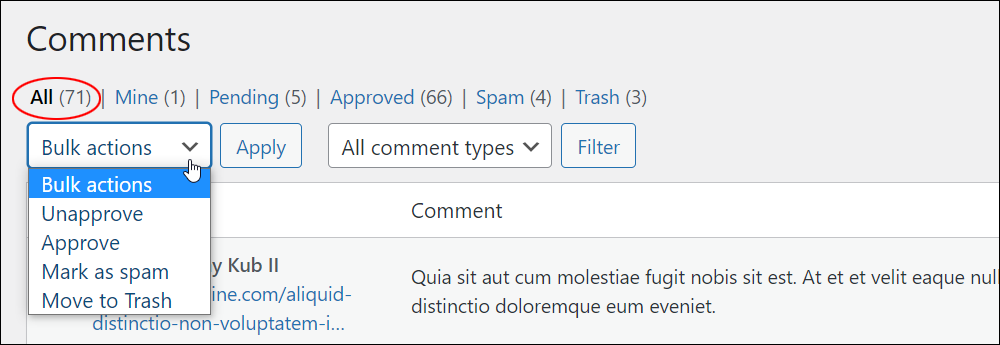
If you have filtered comments using a status filter like Approved, then obviously the option to approve comments will not display as these comments are already approved.

If you’re viewing comments in the Spam section, then the Bulk actions menu will present even fewer options.
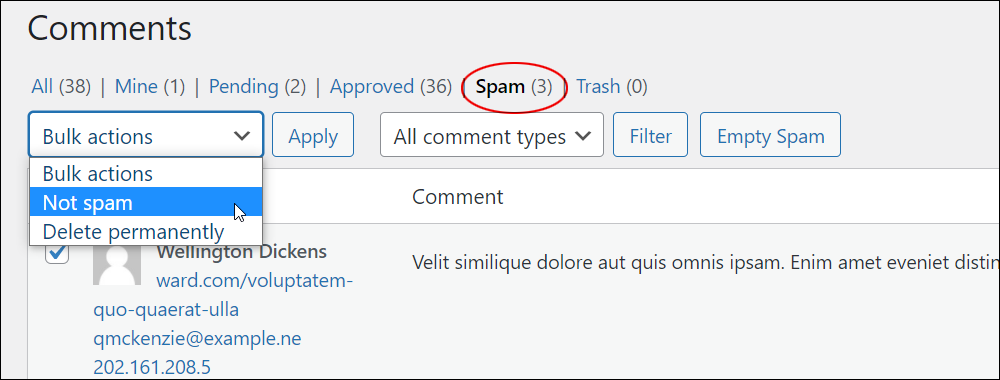
Filter Comments
You can filter comments by various statuses, e.g.:
- All
- Mine (displays only your comments)
- Pending
- Approved
- Spam
- Trash
Click any of the status menu links to filter and display a list of comments with that status.

You can also filter and view a list of comments for a specific post in the In response to column.
The small bubble with the number in it shows the number of approved comments that the post has received. If there are pending comments, a red notification circle with the number of pending comments is displayed.
Click the notification circle to filter and display only pending comments for that post in the Comments screen.

This gives you fine-tune filtering control over pending comments for specific posts.
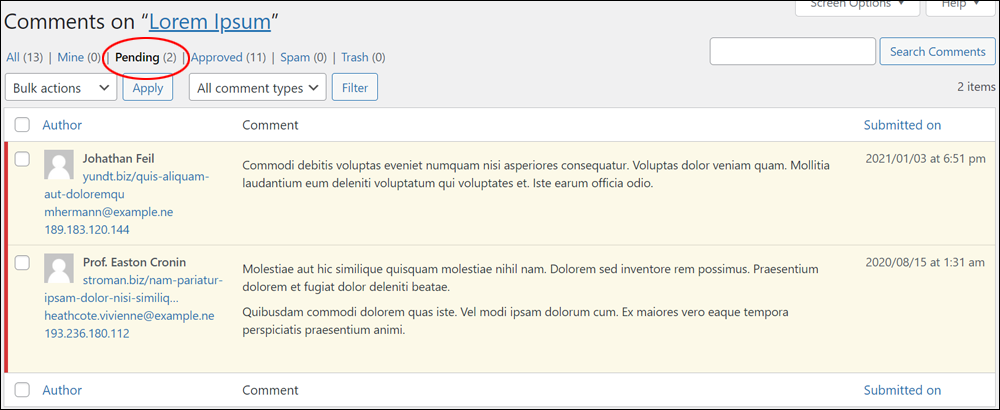
Similarly, click the dialog bubble icon with the number in it (the icon will turn from gray to blue when you hover over it) …
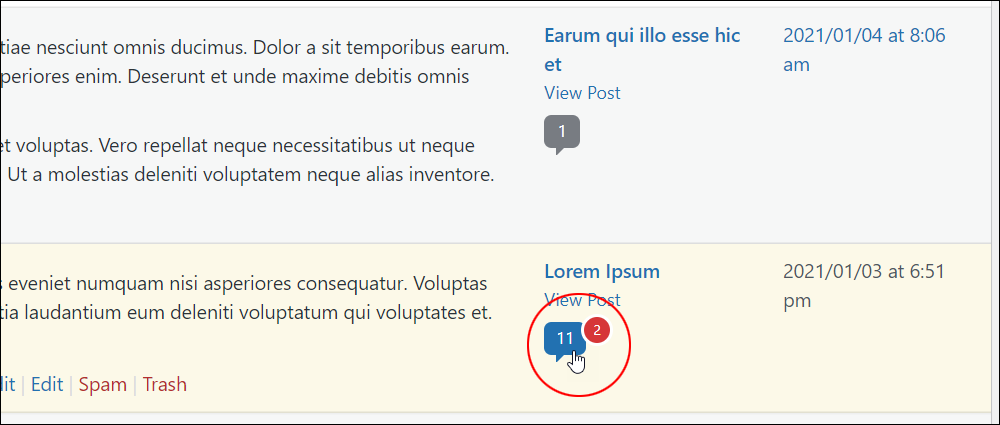
This will bring up a filtered list with all the approved comments for that post.

You can also filter comments by Comment type.
The two comment types you can filter are:
- Comments – Filter and view all visitor/user comments.
- Pings – Select this option to view all ping notifications. (See this tutorial if you need help understanding what pingbacks and trackbacks mean).
Note: If there are no entries for one or more of the above types, these options will not display in the “All comment types” dropdown menu.
To filter by comment type, select one of the options from the menu and click on the Filter button.

You can also filter comments by IP address.
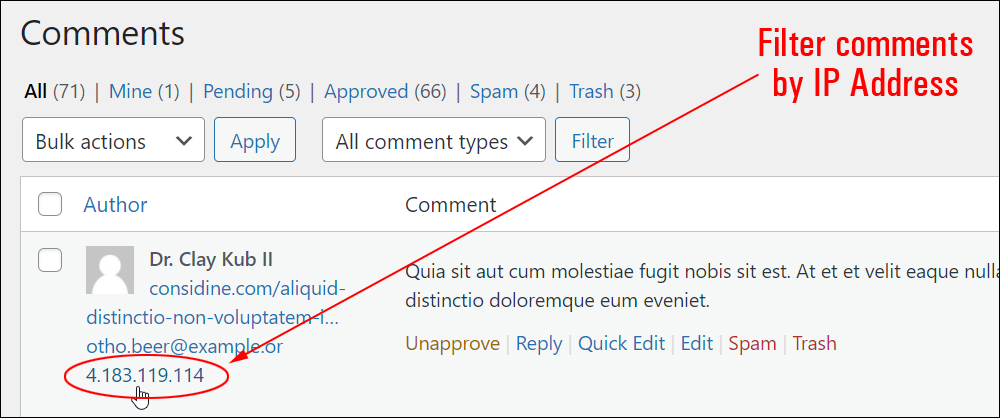
Search Comments
Use the Search Comments function to find comments containing a specific word or key phrase.
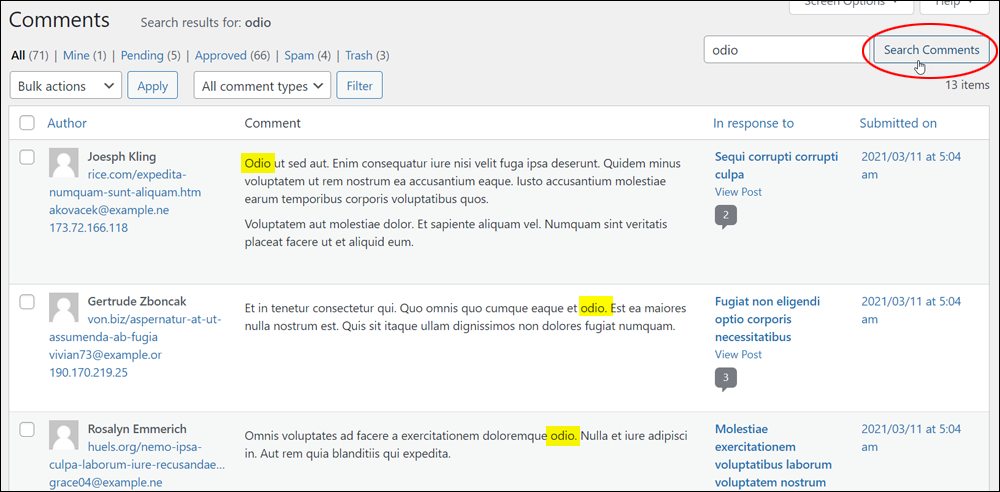
Comment Pagination
If there are loads of comments on your site, the comment pagination feature will help you navigate through your comments pages. (Note: set the number of comments to display per page in the Screen Options tab as shown earlier).

Additional Functions
Click on the View Post link to visit the post on your site.
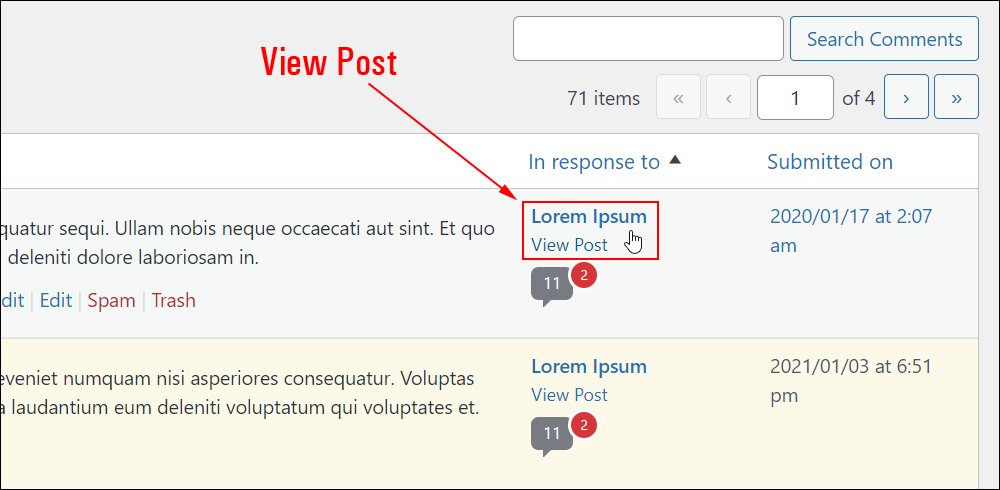
Click on the date/time link to view the comment on your site.
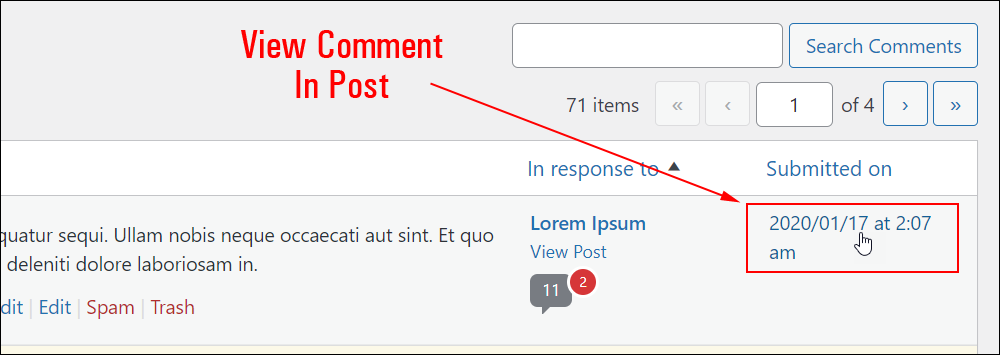
Keyboard Shortcuts
You can use keyboard shortcuts to browse and moderate comments on your site. Keyboard shortcuts are especially useful if your site receives many comments.
![]()
Notes:
- Keyboard shortcuts are designed to use both hands, simultaneously, on a QWERTY style keyboard layout.
- Keyboard shortcuts are used for navigation and for actions. For an action to affect a comment, the comment must first be selected.
- Selected comments have a light-blue background. By default, no comment is selected, so, you press either the letter j key or letter k key to start navigating.
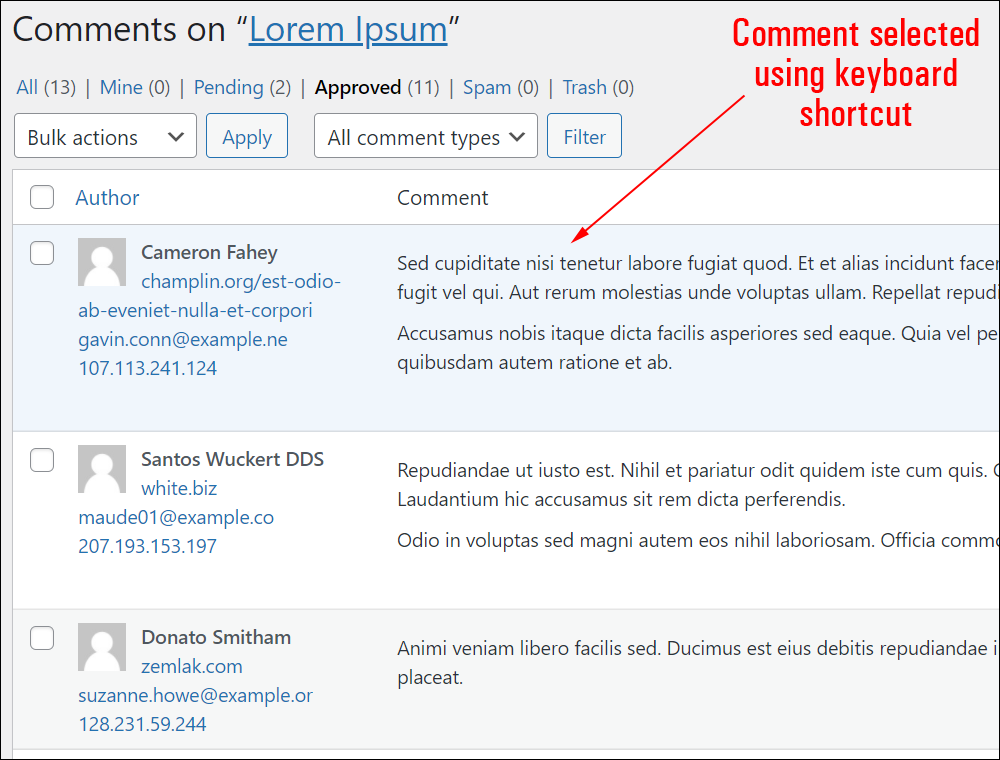
Use the keyboard shortcuts below to save time navigating and performing actions on comments.
Activating Keyboard Shortcuts
Keyboard shortcuts are enabled on a per-user setting.
To turn keyboard shortcuts on, visit the User Profile section (Users > Your Profile) and check the Enable keyboard shortcuts for comment moderation checkbox.
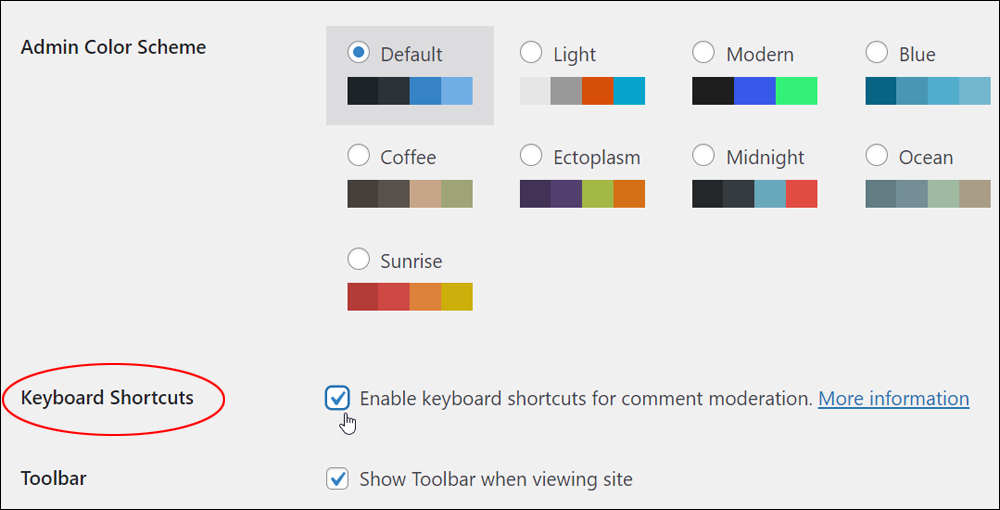
Note: the keyboard shortcuts are designed to use both hands, simultaneously, on a QWERTY style keyboard layout.
Navigating Comments Using Keyboard Shortcuts
To navigate comments, use the j and k keys.
When you first land on the Comments screen, no comments are selected, so press the letter j or the letter k to select the first comment.
After this, press the letter j to select the next comment, and so on.
- Pressing j moves the current selection (light-blue background) down.
- Pressing k moves the current selection (light-blue background) up.
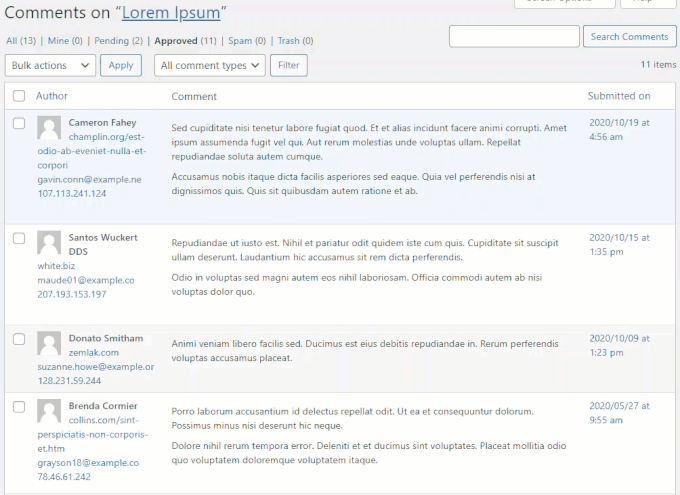
Note: If you get to the bottom of a comments page and press j again, you will be taken to the next page and the first comment on the next page will be selected.
Likewise, pressing k at the top of a comment page will zoom you to the previous page, selecting the comment at the bottom of that previous page.
This makes it easy to navigate and scroll through a long list of comments.
Using Keyboard Shortcuts To Perform Actions On Comments
Make sure the comment is first selected (see above) before applying one of the actions below.
Pressing the key:
- a approves the selected comment.
- s marks the selected comment as spam.
- d deletes the selected comment.
- z restores the selected comment from the trash or activates the Undo when that row is selected.
- u unapproves the selected comment, placing it back into moderation.
- r initiates an inline reply to the selected comment (press Esc to cancel the reply).
- q activates “Quick Edit” for rapid inline editing of the selected comment.
- e navigates to the edit screen of the selected comment.
Bulk Actions
You can also perform bulk actions on multiple comments.
First, select the comments for the bulk action by ticking the checkboxes of all comments you would like to perform the action on.
To select all comments at once, tick the checkbox in the main Column heading.
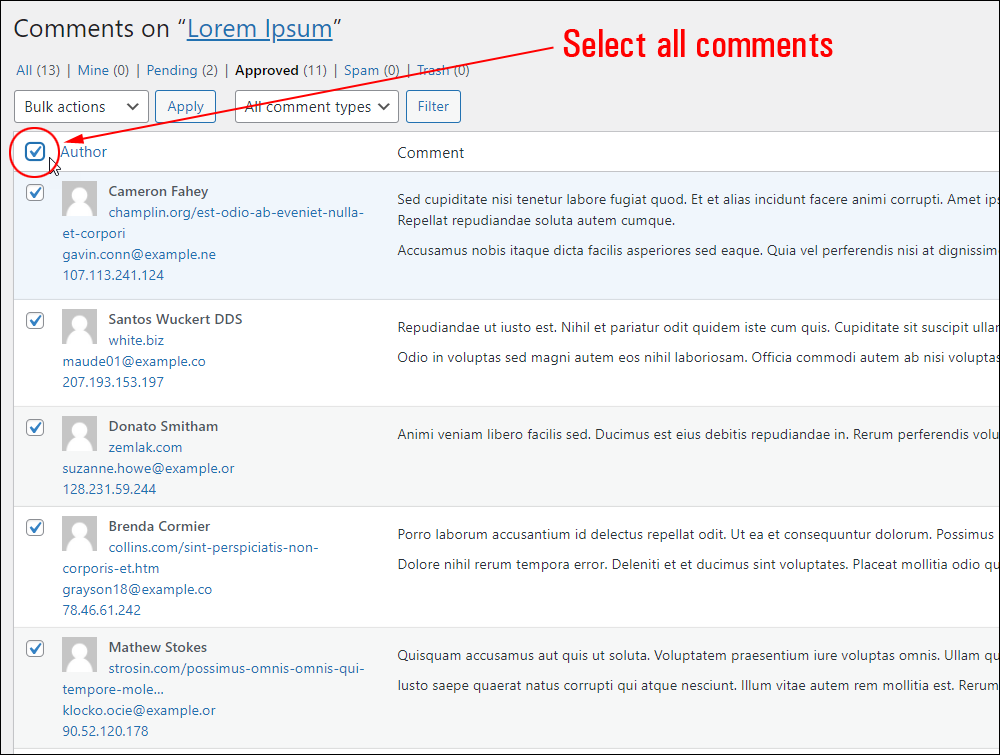
Use Shift-x to toggle the checkboxes, inverting their state.
Once you have checked comments, apply one of the bulk actions below.
Pressing the key combination:
- Shift-a approves the checked comments.
- Shift-s marks the checked comments as spam.
- Shift-d deletes the checked comments.
- Shift-u unapproves the checked comments.
- Shift-t moves the checked comments to the Trash.
- Shift-z restores the checked comments from the Trash.
Additional Comment Sections
Here are some of the additional ways that you can use comments in WordPress:
Displaying Comments In Widgets
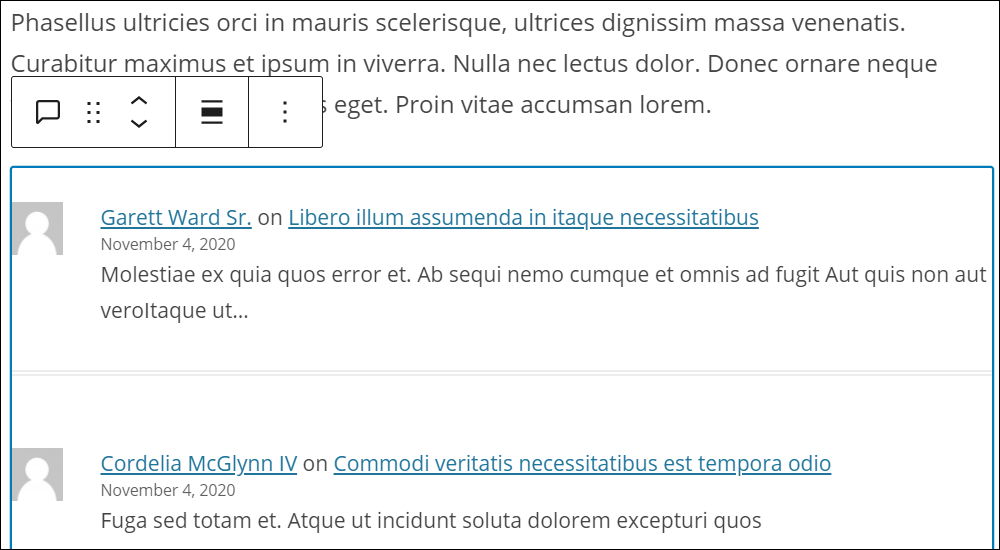
If you use the WordPress Block Editor, you can easily add comments to your posts, pages, and widgets using the Latest Comments block
If you need help using widgets, see this tutorial: WordPress Widgets Explained
Comments RSS feed
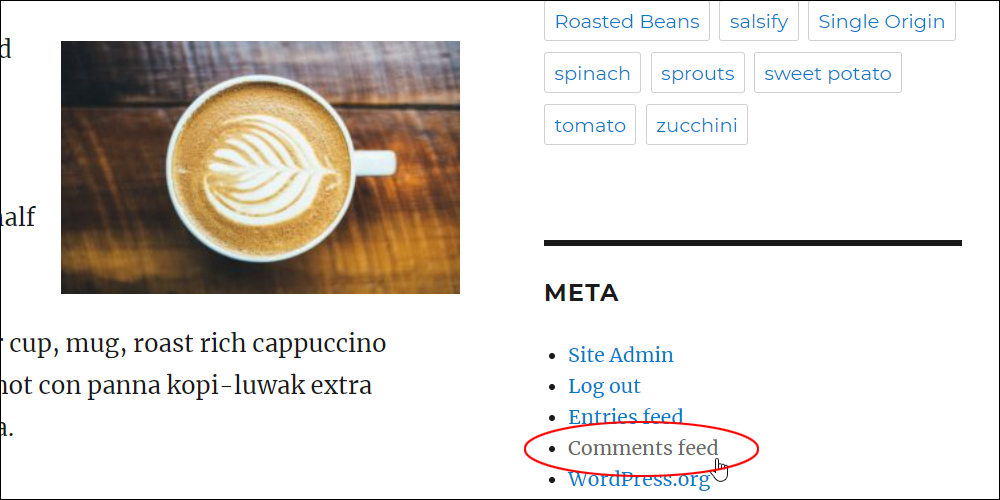
You can syndicate all comments on our site using the Comments feed.
For more information about using RSS in WordPress, see this tutorial: Using WordPress RSS
Comment Plugins
You can extend the functionality of the built-in commenting feature of WordPress using plugins.
Here are just some of the many commenting plugins you can install on your site:
Disqus
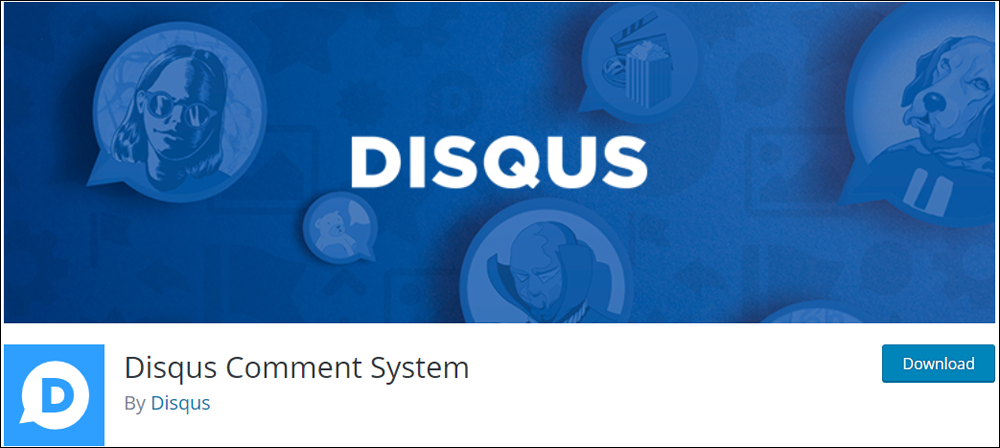
Disqus is a popular comment plugin that replaces the built-in WordPress comments system.
The plugin has an internal system to help reduce comment spam. Users have the option of commenting via their Facebook or Twitter profiles, or their Disqus account, which allows them to comment on any site with the Disqus commenting service installed.
Ads display in the free version and can be turned off by upgrading to a premium plan. Comment moderation takes place on the Disqus website, not in the WordPress admin.
For more information about this plugin, visit this site: Disqus
CleanTalk
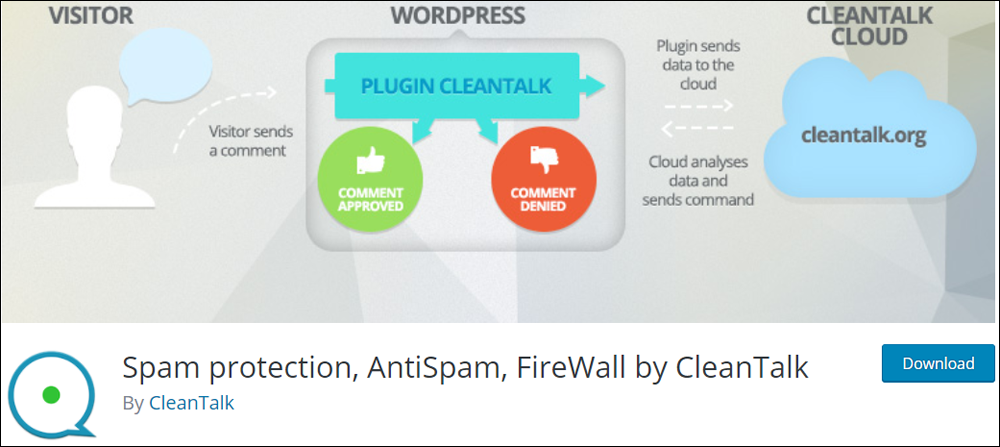
CleanTalk is a free and fast-loading anti-spam plugin that works with a premium AntiSpam cloud service. It offers anti-spam protection from span comments, bot registrations, contact form spam, spam reviews, spam newsletter subscriptions, and more.
You can configure the plugin’s settings to block comments from certain countries, use stop words, etc. It also uses multiple anti-spam tests to filter spam bots, resulting in very low false positives.
When a visitor posts a comment or registers on your site, the plugin communicates with its cloud service, which then analyzes whether the comment came from a visitor or spam bot. Visitor comments get published, spam bot comments are blocked and sent to a spam log which can be viewed in the service’s control panel.
For more information about this plugin, visit this site: CleanTalk
Replyable
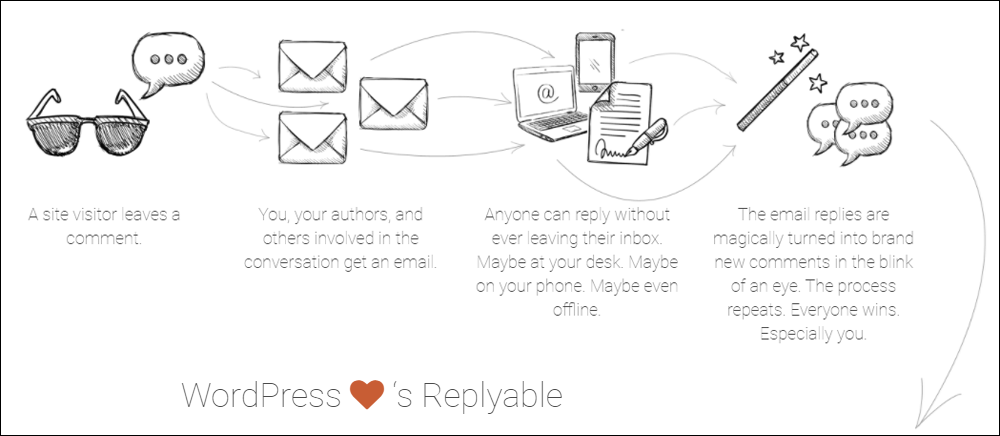
Replyable is a two-way email comment notifications plugin. It is free to download from WordPress.org, so you can install it from your WordPress admin.
You can choose whether to have two-way conversations (post authors can reply to comments) or one-way notifications (receive a simple notification that a comment has been posted).
When a visitor leaves a comment on a post on your site, you, the post author, and anyone who has commented on the post receives an email and can reply directly from their inbox. Replies are then published as comments on the post.
Replyable works with any native WordPress comment system, offers customizable email templates, lets you automatically subscribe authors and guest authors to comments on their posts, and allows authors to moderate comments (e.g. approve, spam, or trash) with simple email commands.
A nice feature of this plugin is that it has a built-in filter that assesses comment content to determine whether the comment adds to the discussion and only forwards the best comments to subscribers.
For more information about this plugin, visit this site: Replyable
Heyoya Voice Comments
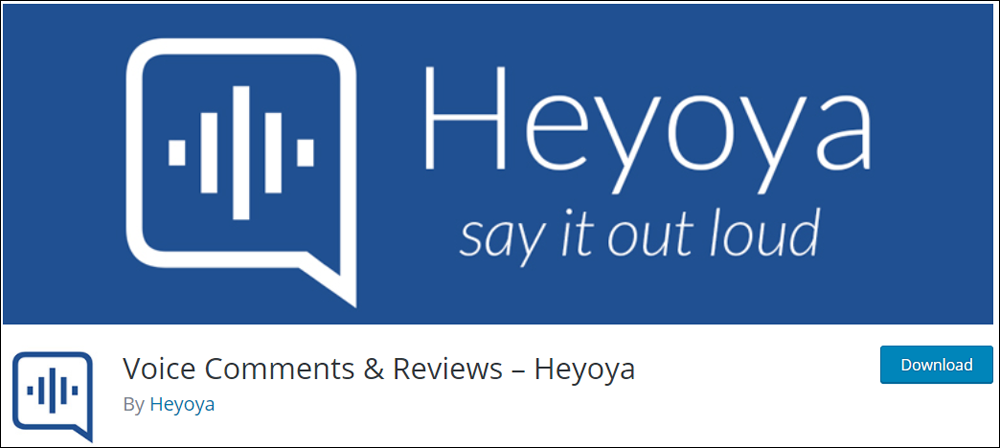
Heyoya allows users to comment using text or voice (or both) and doesn’t replace the WordPress commenting system.
When users leave a voice comment, they can review and re-record it before posting it. Users also have the option of logging in with social media accounts or creating a Heyoya account to submit their comment.
Comments can be moderated in your admin area via the plugin’s page or externally through Heyoya’s website.
Note: To use this plugin and display the Heyoya comments system on your site you will need to add code to your site.
For more information about this plugin, visit this site: Heyoya
Disable Comments
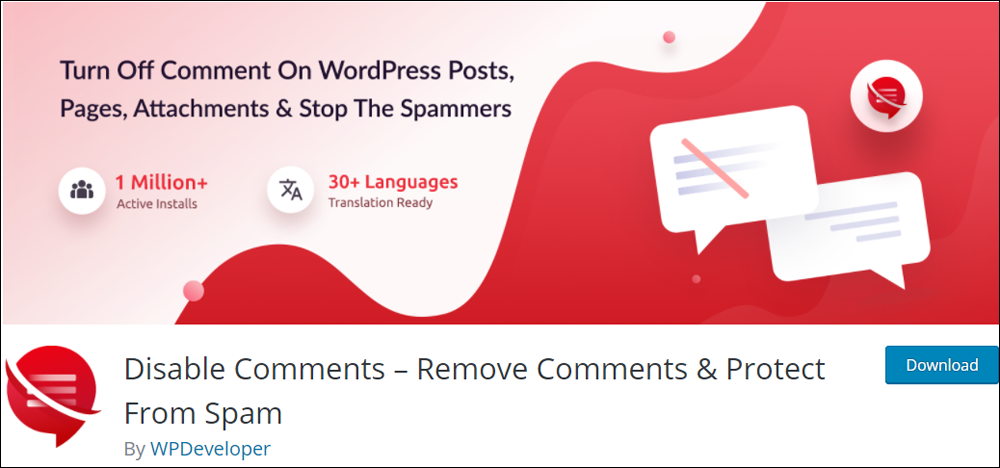
Disable Comments is a free plugin whose function is essentially to disable the WordPress Commenting system on your site.
It lets you instantly allow or disallow comments from any post type in WordPress to stop comment spam and can be configured to “hide” all Comments links from the Admin Menu and Admin Bar, including all comment-related sections and the Discussion settings page. You can also disable comment widgets and comment feeds.
For more information about this plugin, visit this site: Disable Comments
DCO Comment Attachment
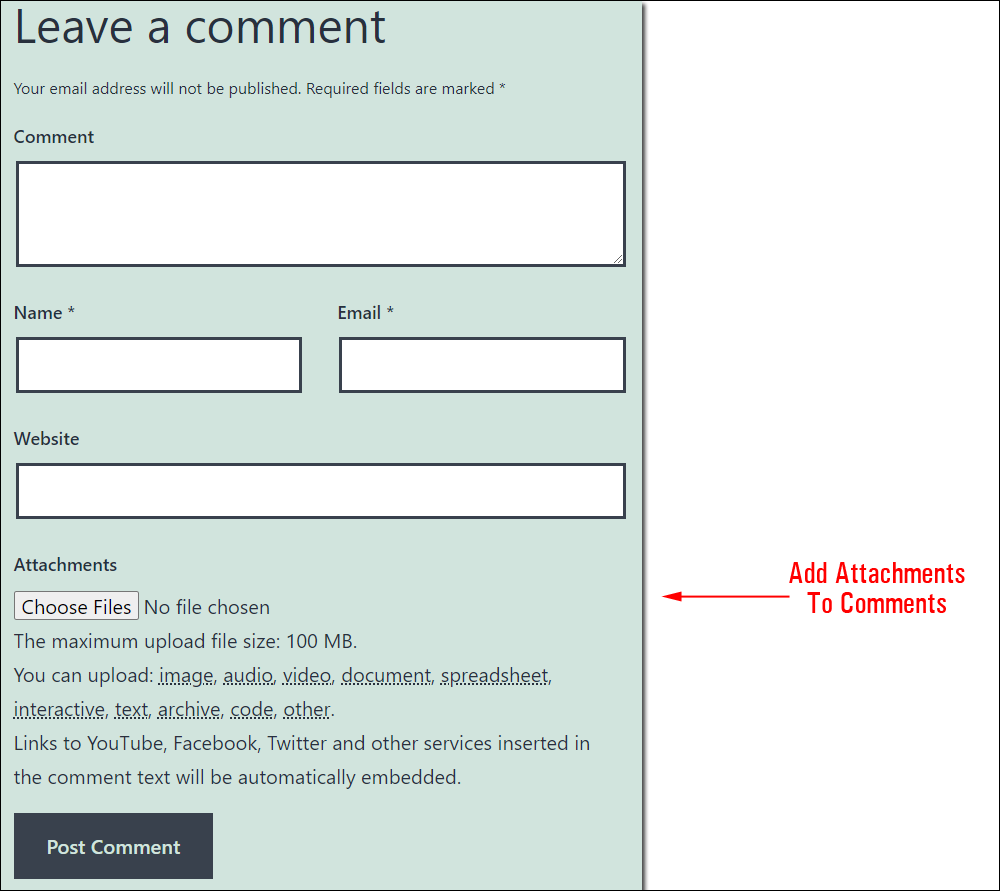
DCO Comment Attachment lets your visitors attach images, videos, audios, documents, and other files with their comments. Users can also automatically embed links from Youtube, Facebook, Twitter, and other services in the comment text.
You can select what type of users can upload attachments with comments (e.g. all users or only logged-in users), limit the maximum file upload size, make an attachment required, specify whether attachments are embedded or displayed as a link, and a whole lot more.
Attachments are uploaded to the WordPress Media Library and can be set to be deleted with the comment.
For more information about this plugin, visit this site: DCO Comment Attachment
Dealing With Comment Spam
If you allow users to leave comments on your site, then expect to deal with comment spam.
WordPress has built-in tools to help combat and reduce comment spam, but it can’t eliminate spam altogether. Comment spammers are always devising new means and methods to circumvent these restrictions.

You can reduce comment spam significantly by making sure that your site’s Discussion settings are configured properly, installing anti-spam plugins, or disabling comments altogether on your site.
For information on what WordPress has to say about comment spam, see the resources below:
WordPress Comment Management – FAQs
Here are frequently asked questions on managing comments in WordPress:
How do I manage comments in WordPress?
You can manage comments in WordPress by navigating to the “Comments” section in your WordPress dashboard. From there, you can approve, mark as spam, reply to, or delete comments as needed.
Can I disable comments on my WordPress site?
Yes, you can disable comments on your WordPress site. Navigate to “Settings” > “Discussion” in your WordPress dashboard and uncheck the box next to “Allow people to submit comments on new posts”.
How can I enable comments on specific posts or pages?
You can enable comments on specific posts or pages by editing the post or page, scrolling down to the “Discussion” meta box, and checking the box next to “Allow comments”.
Is it possible to automatically approve comments on my WordPress site?
Yes, you can automatically approve comments by going to “Settings” > “Discussion” in your WordPress dashboard and checking the box next to “Automatically approve comments”.
How can I moderate comments from users before they appear on my site?
You can moderate comments by enabling comment moderation in your WordPress settings. Go to “Settings” > “Discussion” and check the box next to “An administrator must always approve the comment”.
Can I blacklist certain words or phrases to prevent them from appearing in comments?
Yes, you can create a comment blacklist in WordPress. Go to “Settings” > “Discussion” and add the words or phrases you want to blacklist in the “Comment Blacklist” box.
How do I receive notifications when someone leaves a comment on my WordPress site?
You can receive notifications for new comments by enabling comment notifications in your WordPress settings. Go to “Settings” > “Discussion” and check the box next to “Email me whenever” under “Email me whenever”.
***
Congratulations! Now you know how to manage comments on your WordPress site.
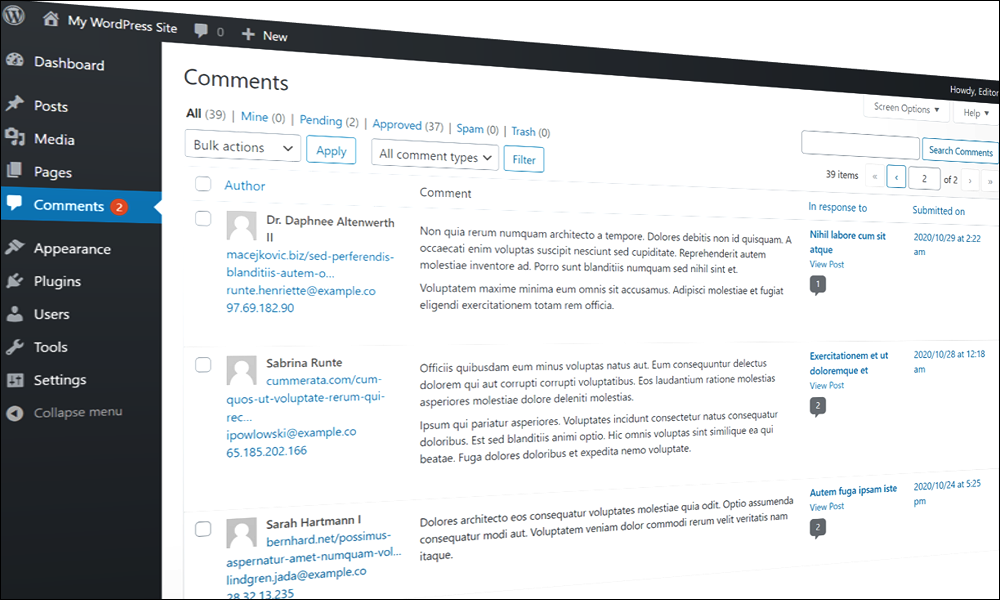
***
Updated: July 5th, 2024
